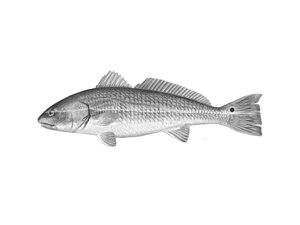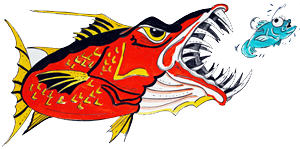Mastering Red Drum Fishing in North Myrtle Beach: Tips and Techniques

Red drum, also known as redfish, are a popular game fish found in coastal waters throughout North Myrtle Beach, South Carolina and the southeastern United States. Known for their hard strikes and powerful runs, red drum provides an exciting challenge for anglers of all levels. In this ultimate guide to red drum fishing, we’ll cover everything you need to know to catch these elusive game fish, from choosing the right gear to mastering the art of presentation.
Red drum fishing is a popular pursuit for anglers of all levels, thanks to the hard strikes and powerful runs of these impressive game fish. Whether you’re a seasoned pro or a beginner, there’s always something new to learn when it comes to red drum fishing.
In this guide, we’ll cover everything you need to know to become a successful red drum angler. From understanding the behavior and preferences of these fish to choosing the right gear and mastering the art of presentation, we’ll provide you with the knowledge and tools you need to make the most of your time on the water.
Biology and Habitat
Red drum are a popular game fish that can be found in coastal waters throughout the southeastern United States. These fish prefer shallow, grassy areas and are often found near oyster bars, grass flats, and mangrove islands. To catch red drum, it’s important to understand their behavior and habitat preferences. In this section, we’ll cover some of the key factors that affect red drum behavior, including water temperature, feeding patterns, and migration.
Gear and Equipment
One of the most important factors in successful red drum fishing is choosing the right gear and equipment. From rods and reels to lines and leaders, every piece of gear plays a critical role in your ability to hook and land these powerful fish. In this section, we’ll cover the essential gear you’ll need for red drum fishing, as well as some tips for choosing the right equipment for your needs and budget.
Red Drum Fishing Techniques
Red drum fishing requires a specific set of techniques and strategies to be successful. In this section, we’ll cover some of the most effective techniques for catching red drum, including live bait fishing, artificial lure fishing, and fly fishing. We’ll also provide tips for selecting the right technique for the conditions and mood of the fish.
Red drum is a popular game fish that is sought after by anglers for its fighting ability and delicious meat. Here are some popular fishing techniques for
- Bottom Fishing: This is a common technique used to catch red drum. It involves dropping a baited hook to the bottom of the water and waiting for the fish to bite. Popular baits include live shrimp, crabs, and mullet.
- Trolling: Trolling is a technique that involves dragging a baited line behind a moving boat. This is a good way to cover a large area of water and find schools of red drum.
- Sight Fishing: This is a technique used to target red drum that is swimming in shallow water. Anglers look for fish in the water and cast a baited hook in front of them. This can be done from a boat or from the shore.
Reading the Water
To be successful in red drum fishing, it’s important to be able to identify the right areas to fish. Red drum prefer shallow, grassy areas with plenty of structure and cover, such as oyster bars, grass flats, and mangrove islands. In this section, we’ll cover some of the key features to look for when searching for red drum hotspots, including structure, currents, and water clarity.
Bait and Lure Selection
Choosing the right bait and lures is critical when targeting red drum. In this section, we’ll cover some of the most effective baits and lures for catching red drum, including live shrimp, soft plastics, and topwater lures. We’ll also provide tips for selecting the right bait and lures for the conditions and mood of the fish.
Casting and Presentation
Proper casting and presentation are critical when targeting red drum. In this section, we’ll cover some tips and techniques for making the perfect cast and presenting your bait or lure effectively, including matching the hatch, varying your retrieve, and watching for surface activity.
Fighting and Landing Red Drum
Fighting and landing red drum can be a challenging endeavor, as these fish are known for their strength and agility. In this section, we’ll cover some strategies for reeling in these powerful fish and bringing them to the boat, including keeping your line tight, using your rod and reel, and using a landing net.
Red Drum Fishing Tips and Tricks
Experienced anglers have developed a variety of tips and tricks for catching red drum. In this section, we’ll share some insider tips that can help increase your chances of success, including using scent attractants, downsizing your tackle, and experimenting with different colors and sizes of lures.
The Nutritional Value of Red Drum
Red drum is a healthy and nutritious fish that is low in calories and fat. It is also a good source of protein, omega-3 fatty acids, and vitamins and minerals. A 3-ounce serving of cooked red drum contains:
- 110 calories
- 21 grams of protein
- 1 gram of fat
- 0 grams of carbohydrates
- 118 mg of sodium
- 326 mg of potassium
- 21 mg of calcium
- 0.2 mg of iron
- 43 IU of Vitamin A
- mg of Vitamin B6
- 0.4 mcg of Vitamin B12
- 14 mg of magnesium
- 44 mg of phosphorus
How to Cook Red Drum
Red drum is a versatile fish that can be cooked in many ways. It has a mild, sweet flavor that pairs well with a variety of ingredients. Here are some popular ways to cook red drum:
- Grilled: Red drum can be grilled on high heat for about 5-6 minutes per side until it is cooked through. Season with salt, pepper, and olive oil for a simple and delicious meal.
- Baked: Preheat your oven to 375°F. Place the red drum fillets on a baking sheet and season with your favorite spices. Bake for 12-15 minutes or until the fish is cooked through and flakes easily with a fork.
- Pan-Fried: Heat a skillet over medium-high heat and add a tablespoon of butter or oil. Season the red drum fillets with salt, pepper, and your favorite herbs. Cook for 3-4 minutes per side or until golden brown.
Red Drum Conservation
As with any game fish, it’s important to practice responsible fishing and do your part to conserve red drum populations. In this section, we’ll cover some tips for practicing responsible red drum fishing, including practicing catch and release, following fishing regulations, and reducing your impact on the environment.
Frequently Asked Questions
What is the best time of year to fish for red drum?
The best time of year to fish for red drum can vary depending on location, but the fall is generally considered prime time for targeting these fish.
What is the best bait for red drum?
Live shrimp is a popular bait for red drum fishing, but soft plastics, topwater lures, and live baitfish can also be effective.
What is the best rod and reel combo for red drum fishing?
A medium-heavy spinning or baitcasting rod paired with a fast-retrieving reel and heavier line is recommended for red drum fishing.
How do you release a red drum safely?
Use proper handling techniques, such as wetting your hands and keeping the fish in the water as much as possible, to minimize stress and reduce the risk of injury.
What is the minimum size limit for red drum?
Minimum size limits for red drum can vary by location. Be sure to check local regulations before targeting these fish.
Is red drum high in mercury?
No, red drum is a low-mercury fish and is considered safe to eat for pregnant women and children.
How do I know if red drum is cooked?
Red drum should be cooked until it is opaque and flakes easily with a fork. The internal temperature should reach 145°F.
What are some red drum recipes?
Red drum is a versatile fish that can be used in a variety of recipes. Here are some popular red drum recipes to try:
- Blackened Red Drum: This recipe involves seasoning red drum fillets with a spicy seasoning blend and cooking them in a cast-iron skillet until blackened.
- Red Drum Cakes: This recipe is similar to crab cakes but uses red drum instead. The fish is mixed with breadcrumbs, herbs, and spices, and then pan-fried until crispy.
- Red Drum Tacos: Red drum is a great fish to use in tacos. Simply grill or pan-fry the fish and serve in tortillas with your favorite toppings, such as avocado, salsa, and cilantro.
Can I eat red drum raw?
No, it is not recommended to eat red drum raw. It should be cooked thoroughly to reduce the risk of foodborne illness.
What is the best way to store red drum?
Red drum should be stored in the refrigerator at a temperature of 32-38°F. It can be wrapped in plastic wrap or aluminum foil and should be consumed within 2-3 days of purchase.
Can red drum be frozen?
Yes, red drum can be frozen for up to 6 months. Wrap the fish tightly in plastic wrap or aluminum foil and store it in a freezer bag or container.
Red Drum vs. Red Snapper: What’s the Difference?
Red drum and red snapper are two popular game fish that are often confused for each other. While they may look similar, there are some key differences between the two:
- Appearance: Red drum has a reddish-copper color with a black dot on its tail, while red snapper is a bright red color with a triangular-shaped dorsal fin.
- Habitat: Red drum is found in the inshore coastal waters of the southeastern United States, Gulf of Mexico, and Atlantic Ocean, while red snapper is found in the deep sea of the Gulf of Mexico, Gulf Stream and the western Atlantic Ocean.
- Size: Red drum can grow up to 40 inches in length and weigh up to 50 pounds, while red snapper can grow up to 35 inches in length and weigh up to 50 pounds.
- Taste: Red drum has a mild, sweet flavor, while red snapper has a firm, white meat with a slightly sweet taste.
Red drum fishing can be a challenging and exciting pursuit for anglers of all levels. With the right gear, techniques, and strategies, even novice anglers can successfully target these impressive game fish. By following the tips and advice in this ultimate guide to red drum fishing, you’ll be well on your way to becoming a skilled and successful red drum angler.
Remember to always practice responsible fishing and conservation techniques to help protect red drum populations for future generations of anglers to enjoy. With a little patience and persistence, you’ll be reeling in these powerful and exciting game fish in no time.
